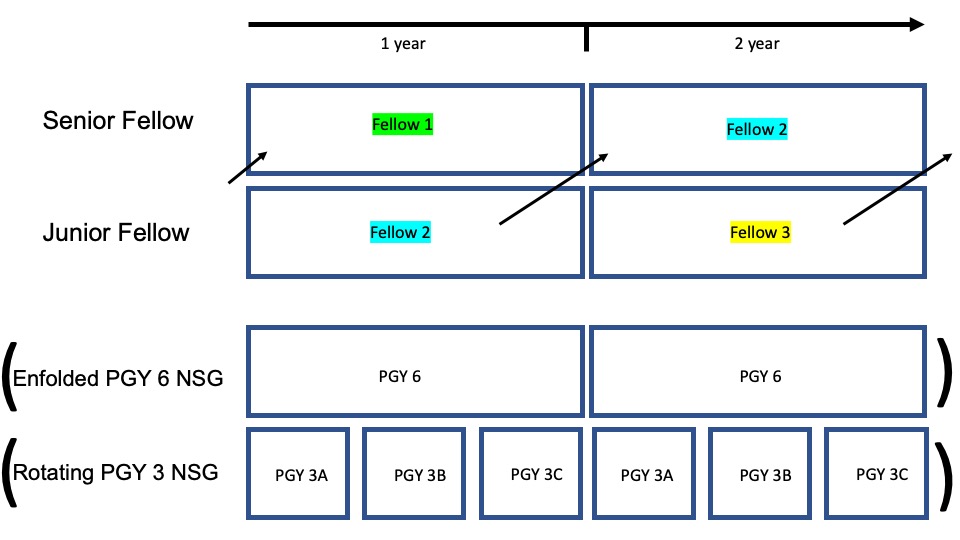Our Endovascular Fellowship Program at Penn consists of 2 years of postgraduate training with a junior and a senior fellowship year. In addition, there may be one or two enfolded additional neurosurgical residents (PGY 6 and PGY3) during part or whole year (see graph). In some scenarios a 1-year postgraduate fellowship may be applicable for candidates completed the required case number in a previously enfolded neurointerventional fellowship year.

There are currently 3 locations for endovascular cases and both junior and senior fellows will cover cases in these locations:
- Hospital of the University of Pennsylvania (HUP), the Pavilion, 3 biplane hybrid rooms, additional biplane rooms – Main site for elective and emergent endovascular cases such as out-/inpatient diagnostic angiograms and treatments, Joint Commission-certified Comprehensive Stroke Center
- Presbyterian Hospital, 1 biplane IR room – Level 1 Trauma Center, inpatient diagnostic angiograms and treatments focused on all neck/head trauma emergencies
- Virtua Our Lady of Lourdes Hospital, Camden New Jersey, 1 biplane hybrid room - Out-/inpatient diagnostic angiograms and treatments, Joint Commission-certified Comprehensive Stroke Center
Junior Fellowship Year
 In the first year the fellow will learn 1) how to set up a catheter angiogram including indication, reviewing preprocedural imaging, risks/benefit discussion with patients, choice of access, positioning, prepping / draping, interacting with nurses / techs, learn PRU / ACT testing, handling radial cocktail other IA medications, patient transport, documentation; 2) how to preform technically a diagnostic angiogram including handling of wires and diagnostic catheters, differences between radial and femoral access, differences of spinal versus cranial angiograms, navigation of wires and catheters, learn robotic assisted angiograms (Corindus); 3) taking primary endovascular fellow call covering endovascular emergencies such as strokes, trauma or neck emergencies (initially with supervision by senior fellow), learning how to set up emergency cases, basics in endovascular treatment such as biaxial, coaxial, triaxial set ups; 4) how to set up and perform interventional spine cases with direct supervision of the faculty 5) assist / the senior fellow / faculty in treatment endovascular cases if the senior fellow is not available or needs assistant.
In the first year the fellow will learn 1) how to set up a catheter angiogram including indication, reviewing preprocedural imaging, risks/benefit discussion with patients, choice of access, positioning, prepping / draping, interacting with nurses / techs, learn PRU / ACT testing, handling radial cocktail other IA medications, patient transport, documentation; 2) how to preform technically a diagnostic angiogram including handling of wires and diagnostic catheters, differences between radial and femoral access, differences of spinal versus cranial angiograms, navigation of wires and catheters, learn robotic assisted angiograms (Corindus); 3) taking primary endovascular fellow call covering endovascular emergencies such as strokes, trauma or neck emergencies (initially with supervision by senior fellow), learning how to set up emergency cases, basics in endovascular treatment such as biaxial, coaxial, triaxial set ups; 4) how to set up and perform interventional spine cases with direct supervision of the faculty 5) assist / the senior fellow / faculty in treatment endovascular cases if the senior fellow is not available or needs assistant.
Senior Fellowship Year

In the second year focus is on 1) how to set up endovascular elective and emergent treatment cases including reviewing preprocedural imaging, risks/benefit discussion with patients, choice of access, complication avoidance and possible management, documentation and post-procedure management; 2) how to assist/perform treatments with direct faculty supervision including performing microcatheter / microwire technique, handling bi- versus triaxial set ups, decision making and handling of different guide, intermediate, microcatheters including pros and cons for the specific case, performing aneurysm coiling/intrasaccular treatment, flow diversion and different liquid embolic / particle embolization techniques; 3) taking primary endovascular fellow call covering endovascular emergencies such as strokes, trauma or neck emergencies with independent set up of the procedure and performing the procedure with direct supervision of the faculty; 4) perform interventional spine cases more independent with supervision of the faculty; 5) taking on leadership roles including organizing fellows call schedule / weekly case conference, help the junior fellow to be successful.
Neurosurgical Residents (PGY 6 and PGY3)
If enfolded residents are present during the rotation of the postgraduate fellows the postgraduate training will be prioritized, but it is expected that both junior and senior fellows will support the resident education together with the faculty by teaching basics of endovascular techniques, access and diagnostic catheter angiography.